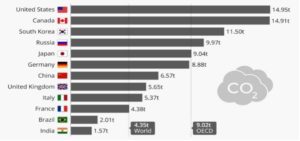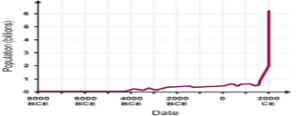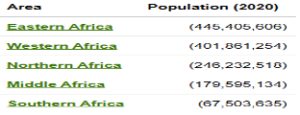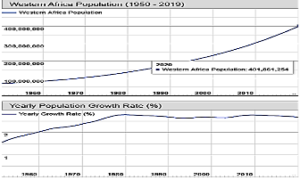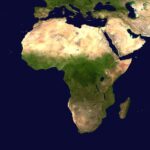1. ABSTRACT
The global population in recent times has rapidly increased despite several untoward situations and factors. However, population growth—as excessive and unsustainable—is only affecting specific areas. Countries like Japan, Latvia, Bulgaria, and Italy, and many others face a reverse situation. Following this, researchers have hypothesized that population size is a crucial factor in measuring environmental impact. This study provides an overview of the environmental impact of population growth in Africa with particular reference to Nigeria. An examination of the general population impact in Africa shows negative interactions of high population growth and unsustainable development, suggesting that the continent’s population growth can pressure the environment, making it difficult to maintain its natural order. In Nigeria, concerns have been raised about the potential for overpopulation and population growth’s increasing impact on its ecological carrying capacity and available natural resources. It is understood that the reduction of the population growth rate can assist in development that can provide essential services and improve poverty eradication policies. The study recommends that the federal government embark on an intensive awareness program to educate the general populace on the effects of an uncontrolled population growth rate on resources and the environment. An effective birth-control system is also advised to help manage the birth-rate while developing a comprehensive population policy for sustainable development with population growth rate management as one of its critical policy Agenda for Nigeria
2. INTRODUCTION
Five years after the revolutionary “Earth Summit” at Rio de Janeiro, “the global environment has continued to deteriorate, and significant environmental problems remain deeply embedded in the socio-economic fabric of nations in all regions.” This was the conclusion made by the Global Environment Outlook Report released by the United Nations Environment Program (UNEP) in Nairobi, Kenya.[1] It is clear from the report that international and national efforts, politically and in funding, were not sufficient in making effective policies towards achieving a decline in global environmental degradation.
The Global Environment Outlook Report identifies principal environmental issues confronting major regions. In regions where food security and poverty alleviation were priorities, such as Africa, West Asia, and parts of the Asia-pacific region and Latin America, the primary concern is land—its availability, the prevention and control of land degradation, and efficient land and water management.[2]
As the global population has grown and become wealthier, the demand for resources has increased at an astonishing rate. The latest UN world population projection (medium-fertility variant) estimates that it could reach 10 billion around 2050, marking the second consecutive upward revision on this estimate. This correction of earlier – overoptimistic – estimates is an important reminder that the efficient use of the world’s resources will be essential to limit environmental damage and reduce the social and political disruptiveness of scarcity challenges.[3]
Population size is a crucial factor in evaluating impacts on the environment, together with those coming from consumption patterns, affluence overuse, wastage, and misuse of resources has strained the capacity of the Earth to sustain life. It has now become imperative to study and control the human population.[4]
Figure 1: Global Disparity in Carbon Footprints: per capita of CO2 emissions in the world’s largest economies in 2016 (in metric tons).[5]
It is considered in many quarters that one of the major root causes of several environmental challenges such as degradation is caused by increasing extractive activities required for various industrial capacities. Growth in industrial capacity for exports and consumption grows an economy. In order words, the desire for growth can be one of the significant factors considered by concerned groups as the significant cause of instabilities in our environment and depletion of natural capital. Years ago, the human population was kept low due to difficulties in producing enough food, which caused high mortality rates. However, this has changed—humans evolved, became more industrious, and needed materials and resources to fuel his newfound success—enter the era of environmental degradation and climate change.[6]
In 2015, it was recorded that the world population index grew above 7.3 billion people.[7] That amounts to more than seven billion three hundred million persons that require nutritious food, health care, and clothing. The presence of more people on the planet poses a challenge but not a disaster. There is plenty of room and enough food. However, the issues to surmount are the management of disparities, the long-term sustainability of resources, and societal transformations that lead to manageable population increases in the regions concerned about the LDCs. By 2050, it is calculated that the population would reach the 9.2 billion mark at the current population growth rate.
In the early years of human existence, the human population growth rate had been slow and manageable, kept in check by disease, climate fluctuations, and other social factors. The human population did not get to the 1 billion mark until 1804. However, due to continuing improvements in nutrition, medicine, and technology, death rates have declined to cause an inadvertent increase in the world population.
The impact of the growing population and activities on the environment takes two primary forms:[8]
- Increased consumption of resources such as land, food, water, air, fossil fuels, and minerals
- Increased production of waste as a result of consumption such as air and water pollutants, toxic materials, and greenhouse gases
- In the last 500 years, agricultural development has helped propel and sustain the current population explosion and growth rate. Unlike other species on the planet, humans have the power of adaptability and can thrive under various environmental and climatic conditions the planet has to offer.
Figure 2. Humans Population Growth over the past 10,000 years.[9]
Figure 3. Humans Population Today.[10]
The graphs (Figure 2 and Figure 3) show that the human population increases every year, resulting from a higher life expectancy due to improved health and lower death rates. In the last 50 years, the population growth rate was higher than ever before, resulting in an increased population from 3 billion to 7 billion people.[11] An increase higher than any point in the history of the planet.
It is projected by 2050; the global population would have reached about 10 billion, requiring severe interventions in food security to stave away malnutrition and starvation. The plan of action to be taken is the urgent need to understand the planet better—how it functions and how it can bear the rapid changes. The points following are the challenges that present themselves to policymakers and thinkers in the twenty-first century.[12]
- The increased population growth rate of about 74m people per year.
- The occurrence of an uneven distribution of population density globally
- Researchers are until now not able to determine the humans ‘carrying capacity of Earth conclusively
- Other factors are influencing the environment apart from population
- the rate of consumption of natural resources has been unprecedented when measured over the last 50 years.
- The 20thcentury saw the most significant increase in the world’s population in humans history
Some observers have concluded that population growth is the leading cause of our environmental crisis. The classic statement of this position is Ehrlich’s assertion that:
The causal chain of the deterioration [of the environment] is quickly followed to its source. Too many cars, too many factories, too much detergent, too many pesticides, multiplying contrails, inadequate sewage treatment plants, too little water, too much carbon dioxide—all can be traced easily to too many people.[13]
It is therefore opined that concerted global efforts towards resource management and environmental sustainability require much urgent action.
3. OUTLOOK OF POPULATION GROWTH ON THE ENVIRONMENT
3.1. Africa
Africa’s population growth rate continues to pose enduring challenges to environmental and development efforts on the continent. Africa’s population is estimated to roughly double by 2050, increasing the continents 2019 population of 1.3 billion by 1.2 billion. One of the significant suggestions made was to bring in policy directives that sustainably disincentivize families from having large families. There are, however, ethical issues around this. However, it has been discovered that high fertility is driven by multiple factors, including sizeable desired family size, low levels of modern contraceptives, and high levels of adolescent childbearing.[14]Furthermore, the total fertility rate data from the World Bank[15] suggest that the world’s highest fertility rate is in Africa.
Looking at the basic facts about Africa’s population (see i and ii); statistics show that Africa’s population is equivalent to 16.72% of the total world population—the second most populated region on Earth after Asia, but according to Data, the pollution rate in Africa cities is less than in most European agglomerations. Notwithstanding this positive fact in the present, there is yet a challenge impending: that which has to do with land allocation for Africa’s growing population and the exploitation of its natural resources causing untold environmental damage and pollution, further putting more pressure on the already scarce land available for agriculture and living.[16]
4. BASIC FACTS ABOUT AFRICA: POPULATION CENSUS (2020)[17]
- The current population of Africa is 1,340,729,505 as of Monday, July 6, 2020, based on the latest United Nations estimates.
- Africa’s population is equivalent to 16.72% of the total world population.
- Africa ranks number 2 among the world’s regions (roughly equivalent to “continents”), ordered by population.
- The population density in Africa is 45 per Km2(117 people per mi2).
- The total land area is 29,648,481 Km2 (11,447,338 sq. miles)
- 8 % of the population is urban (587,737,793 people in 2019)
- The median age in Africa is 19.7years.
Figure 4: The Population of Africa (1950 – 2019)[18]
The environmental dynamics of developing nations have been an issue in many different discussions. It is noted that the declining quantity and quality of several natural resources, namely land, forest, and water, portend a gloomy ecological future for these countries—especially Africa. Thus, as pressure on the environment grows, most African nations will have to focus on mitigating the antagonistic interactions of high population growth and unsustainable development if they are to have any chance of maintaining the natural order of the ecosystem, such as the rich flora and fauna Africa is known for since the continent was opened to the world.[19]
Land degradation and soil erosion often lead to deforestation and desertification caused by principal agents like wind, water, and ice. Water has also become an emerging environmental issue in many of these countries. In rural areas, the challenge comes from overuse, depletion, and contamination. Boserup writing in 1965 (from his quote above), explains the impacts of population growth on the environment. There is a need to come to terms that there exists complex dynamics of population growth in the environment to forestall the ills of going beyond the limits of an ecosystem’s carrying capacity, although Boserup thinks otherwise.[20]
4.1. West Africa
In the sub-Saharan region, understanding the population movements is essential as the regions are currently experiencing the highest growth rates.[21] Generational forecasts illustrate the extent to which countries of the region must endeavor in terms of education, access to health care, environment, and employment. These forecasts indicate that the reconstitution of settlement patterns (changes in population geography) is not a concluded matter. It is understood that a high population growth rate can be a consequence of migrations.[22]
The results of a high demographic number can be seen in the effects on the economy and the environment. There is also a link between a high population and the many West African conflicts caused by limited land for farming, ranching, and living.[23] As shown in the population distribution in West Africa from 1950 – 2019 and its population growth rate (Figure 5), the growth rate of 3.8% in 2017 is a call for concern. West Africa is home to 3.9% of the sub-Saharan African population (with East Africa just behind at 3.8%).[24]
Figure 5: West Africa Population (1950- 2019) and Growth Rate.[25]
Sub-Saharan Africa suffers from some serious environmental difficulties such as deforestation, soil erosion, desertification, wetland degradation, and insect infestation. Efforts to solve this problem have been futile, and many see West African’s as irresponsible toward the environment and look to the international community to save them from themselves.[26] However, three main factors are predisposing environmental degradation in West Africa—population distribution, a high foreign debt burden, and the absence of democracy.
4.2. Nigeria
The Nigerian Conservation Foundation (NCF) and the Lagos state government have raised concerns over the increasing impact of population growth on Nigeria’s environmental resources. Both state actors have called for urgent actions to help ensure a balance between population growth and the environment’s carrying capacity. The Director-General of the NCF advised the federal government to intensify efforts in the girl child’s education on limiting the number of children planned for their generation. [27] The Nigerian Population Commission (NPC) Chairman, Eze Duruiheoma, estimated that Nigeria’s current population, which hovers around 198 million people live predominantly in an urban setting. He said this growth rate in the past 50 years has been close to 6.5 percent at an annual rate.[28]
It is estimated from various data sources that Nigeria’s population range from the World Bank’s 186 million to 205 million by UN agencies. An accurate census is difficult in Nigeria due to infrastructural shortcomings. In the past, census results have also fueled ethnic and religious conflicts exploited by political figures. We can only now rely on intelligent estimates. [29] It was raised in a meeting in New York by the country’s population commission boss that social amenities are not meeting up with population growth requirements. However, the country’s rapid population growth, especially in urban areas, poses complex economic, social, public health, and environmental challenges.[30]
At the moment, Nigeria’s growth rate is projected at 2.56% (see figure 6) annually.
Figure 6: Nigeria Population (2020) and Growth Rate.[31]
Under the double-time growth analysis, this high growth rate computes that Nigeria’s population will be expected to have added 3 million persons in one year. This infers that at a 2.56% growth rate, it will take 27 years for Nigeria to double its population from the current size.[32]
- DT = 70/GR[33]
- DT – Doubling time in Years
- GR – Growth rate in percentage
There is a need to mention that some factors or fundamental properties somewhat control the doubling time (see iii), further elaborated below.
4.3. Critical Properties of Doubling Time in Ecology
- The doubling period is faster when the growth rate is enormous.
- The rate of growth varies considerably among organisms. For example, most small-bodied organisms grow faster and have more significant population increases than bigger creatures.
- The doubling of the population is limiting and levels off with time due to constraints coming from nature, such as disease and famine. This phenomenon is called logistic growth.[34]
The seriousness of the effect of population growth above planetary boundaries, for example, in Nigeria, has caused the following impacts on the environment.[35]
- Non-renewable resource consumption and depletion like crude oil, natural gas, coal, and solid minerals
- Land degradation and inadequate waste disposal protocols
- Changing effects of weather and climate with longer raining seasons, rising sea levels, and desertification in the northern parts of Nigeria
- Urban areas like Lagos, Abuja, Port-Harcourt, Kano, and Niger state experience more significant pollution of their soil, water, and air.
5. Implications of a Rapidly Growing Nigerian Population
A rapidly growing population like Nigeria has many effects. Some of the effects appear to be beneficial—in the short term, while others are counterproductive and directly affect the quality of life and the environment. The essence of this section is to discuss the impacts Nigeria’s high population growth rate has on the environment.
Rapid population growth harms humans development, provision of essential services, and poverty eradication; these effects are magnified and become more urgent in the context of climate change. Reducing population growth has long been a development goal because of the detrimental effect of rapid population growth on economic development.[36]
The sub-regions population growth rate has perpetuated extreme poverty. With a significant reduction in the percentage (from 45% in 1990 to 41% in 2004), the number of people living in extreme poverty increases (by more than 55 million) due to population growth. High population growth, fueled by high fertility, impedes progress towards achieving the Millennium Development Goals (MDG) and sustains poverty, the central phenomenon underlying vulnerability to climate change.[37]
This situation is illustrated by a series of developing country-led reports, the National Adaptation Programs of Action (NAPAs), which document the most critical vulnerabilities to climate change impacts and the most urgent adaptation priorities. Nearly all (37 of 40) NAPA reports refer to population growth as a significant factor that exacerbates climate change’s harmful impacts. They describe the impact of population growth on freshwater availability on land degradation and soil erosion through over-grazing, deforestation, and migration to coastal areas vulnerable to rising sea levels, floods, and cyclones.[38] The effects of a high population growth rate have been succinctly summarized in the three bullet points following:
- Rapid population growth acts collaboratively with climate change to deplete critical natural resources, such as water, fuel, and soil fertility.
- Rapid population growth can cause an onset of environmental degradation and climate issues due to over-exploitation of natural resources. [39]
- Population growth heightens human vulnerability to climate change in numerous ways. It may force people to migrate to either environmentally marginal or more at risk of climate change’s negative impacts. For example, population growth in Tiv land, Benue State Nigeria, is causing land resource conflicts where large-scale killings and destruction have been known to occur. Other resultant effects are soil degradation, dwindling landholdings, and low agricultural productivity caused by intra-tribal conflicts and inter-tribal wars with migrants who are also now placing a stake on land, which is already not enough for the indigenes. These various crises bring in instabilities on the poor, and in order to survive, the vulnerable indulge in unsustainable practices that further damage the environment and increase rates of poverty.[40]
6. Factors Inhibiting Population Control in Nigeria
Population growth on living standards is a significant concern in most developing countries, including Nigeria. Nigeria’s unprecedented growth rate and currently hidden population momentum are current issues of common concern. There is a need for the government to make now conscious efforts that would reduce rapid population growth. This would improve the standard of living of the Nigerian populace. This can only happen if the factors influencing population growth are known, leading to effective population growth regulation.[41] The international community has also made it clear that the dire economic and social woes associated with uncontrolled population growth are not far off. Therefore, many African countries like Nigeria are now devising effective policies and measures for controlling the population.[42]
The UN World Population Prospects report published in June 2013 revealed that Nigeria’s population is expected to exceed that of the United States by 2050. The report said that by the end of the century, Nigeria could start to rival China as the second-most populous country in the world. Nigeria, a country in the third position in terms of population and with the highest population of impoverished people (World Bank report, April 2014) of 122 million. There is a prevalence of unemployment, poverty, lack of basic amenities, poor environmental conditions, degradation, religious influences[43] , and a weak economy. Some of the critical factors[44] affecting population growth in Nigeria are:
- Weak political institutions provide for a government that operates frail programs concerning population management. There are not enough facilities to control the number of people, such as health centers where family planning instructions and methods can be accessed.
- Population growth can be influenced by illiteracy, strict customs, and lack of knowledge on preventing pregnancy (access to adequate birth control) or proper family sizing.
- The provision of inadequate health systems in Nigeria makes large families live after one in high mortality cases.
- Old-age social security is an old African way of providing social security for the future. Having many children was not just a tradition; it was the only support for the older generation’s existence.
- Religious belief systems are also a contributing factor. Catholics do not accept and believe that conception should be controlled, neither should abortion be considered an option. Muslims accept as true that the primary role of a woman is for childbearing in marriage.
- Many social actors influence the desire to have children, such as early marriage, with a male-orientated culture (men work, women – bring the children up).
- Immigration and emigration are factors to affect the demographics of a place. It is humans to search for better living conditions. When economic development and new technologies increase in certain areas, there is an attraction for more and more people to immigrate into such areas; for example, Lagos has an approximate population of 14.5 million. In contrast, Abuja has a 2020 population estimate of 3.2 million people, with a growth rate of 5.9%.[45]
- There is an underlying culture in many African societies that encourages marrying many wives and having lots of children. There is also an inclination of male-infant preference in Nigeria. Many tribal belief systems exist that a male child is superior to a female, and birth is continuous until a male child is born. This belief system has caused surges in population growth rate in many African states, especially Nigeria.
7. POLICY ASSESSMENT AND RECOMMENDATION FOR THE NIGERIAN SITUATION
Several research findings have shown that other factors support the interaction between population, development, and the environment. Reports from studies have revealed that the significant underlying agent of environmental degradation in Nigeria is caused by the impact of its growing population together with increasing poverty. This outlook is a threat to its policy Agenda on sustainable development.
Also, the combination of population pressure on the land and the prevailing often unsustainable agricultural land-use practices have accelerated deforestation in the northern parts of Nigeria and the many places on the African continent. In most parts of the region, the cultivation of marginal lands has the attendant effect of environmental degradation, further eroding the soil, depleting shallow water resources, and creating greater poverty.[46] This chapter is focused on—a probable answer—the workable policy directions that may help reduce Nigeria’s population growth rate to such a level that would allow for good life and sustainability concerning the ecosystem.[47]
Notwithstanding Nigeria’s position in today’s global population ranking, a clear direction of having a population policy was not muted until the 1980s when the Nigerian government realized that its population size and growth rate were becoming a problem. A good fortune from sales of petroleum in the early 1970s made the issue of a growing population a non-challenge until prices fell to USD 11.00 per barrel in the 1980s.[48]
It is noteworthy that, before the glut in oil prices, Nigeria had participated in some global programs that aimed at controlling births in developing countries, such as the World Population Plan of Action (WPPA) of 1974, the Lagos Plan of Action (LPA) of April 1980, the Monrovian strategy, and the Kilimanjaro Programme Action adopted by the African council of ministers in 1984. The programs all suggested that countries embrace population policy to reduce the birth rate and increase development. However, the Nigerian government never paid attention to any of these policies until the fall of the oil boom.[49] As a response to falling oil prices[50] and increasing population with its associated negative socio-economic consequences due to rapid population growth, Nigeria’s government adopted a national policy on population for the development, unity, progress, and self-reliance to achieve the primary goals of decelerating the rate of population growth.
Nigeria’s first national policy on population was promulgated in 1988 and later reviewed in 2004.[51] Nigeria’s policy direction to manage its growing concern on its population was the use of Malthus’ theory of population as a guide for its formulation of strategies as adopted by many other nations globally. However, these policies ignore cultural aspects. Individual fertility behavior takes place within the context of complex social, cultural, and ideological realities. This position sees demographic behavior as “part of a larger, more complex whole of behavioral patterns, learned as part of the general repertoire of behavior in a social group.”[52]
8. What is the solution?
8.1. A Global Perspective
Joel Cohen[53], a mathematician, and author characterized potential solutions in the following way:
8.2. Technical Innovation
This concept looks to innovation and technology as Earth’s savior, not only to extend the planet’s human carrying capacity but also to improve each individual’s quality of life. Technology helps bridge the gap, assisting in improvements in plant selection, water systems, and manufacturing pieces of machinery to aid in feeding the majority of the populace and reduce the use of fossil fuels to renewable sources. These policies can assist in the reduction of greenhouse gases and retard climate change.
“Economic decoupling refers to the ability of an economy to grow without corresponding increases in environmental pressure.” In 2014 the United Nations Environment Programme released a report titled “Decoupling 2,”[54] which explored the possibilities and opportunities technology and innovation may have in assisting in hastening the processes that enhance decoupling.
8.3. Effects Education and Policy Change on Population Growth Rate
It has been theorized (Demographic transition) that when resources are scarce, it inevitably forces people to have fewer children. Access to birth control resources and sexual education is an effective strategy for slowing birth rates. Likewise, as individual incomes in developing countries increase, there is a corresponding decrease in birth rates.
8.4. Less is More
There is a need for everyone to adopt a better manners approach designed to educate people about their actions and the consequences of those actions, leading to a change in behavior at the individual and government level. Several research findings have shown that having more does not make people happier.[55]
It is advised that various governments move towards policies and agendas that support natural conservatories’ protection, lower CO2, and look in infrastructural upgrades towards renewable energy sources. Without support, less developed economies cannot achieve many of the Climate Change Goals because the resources required to do so are not readily available.
In reality, there is no single, easy solution. All three options discussed in the preceding chapters should necessarily be part of a sustainable plan. Remarkably, despite that population increase is such an issue to be worried about, the United Nations has held only three world conferences on population and development (in 1945, 1974, and 1994).[56]
Nevertheless, governments worldwide are beginning to recognize the seriousness and importance of the situation and reduce the environmental impacts of increasing populations and consumption. The United Nations Climate Change Conference in Paris (UNCCCP)[57] is one good example; however, it is a good rule of thumb that any international policy should have the backing of a workable solution-strategy at the local, state, and regional levels.[58]
9. The Nigerian Perspective
The Nigerian perspective on population growth and its impact on the environment is interwoven with its policy towards sustainable development. Sustainable development focuses on future generations and the ability of the present generation to provide for that generation.[59] In this wise, it cannot be discounted that the current population number or growth rate directly affects sustainability or sustainable development.[60]
Nigeria’s environmental and population policies are relatively new compared to its time of independence. Due to weak successive policy formulations in the last 40 years (1960-2000) of Nigeria’s post-independence economic development, strategies towards development and environmental accounting policies restricted to the bidding of interests from its former colonial power. Before the 1972 United Nations Organization (UNO) conference on the human environment held in Stockholm, Nigeria as a nation did not establish a legal or economic framework for the supervision and monitoring of environmental issues; instead, and much attention was given to industrialization, indigenization, and full exploitation of the available raw materials.[61]
10. Population and Environmental Policies: Expectations in Principle and Realities
The socio-political and economic aspects of policies where adequately formulated and implemented policies help provide solutions to reinforce the strict adherence to the principle of policy implementation.
There are five policymaking processes: policy agenda, policy formulation, policy adoptions, policy implementation, and policy evaluation. These serve as a mechanism(s) through which a policy can passage from thought process or ideology into substantiated written codes.[62]
Because of the above, environmental and population-related policies in Nigeria are assumed to have first moved from conception to implementation. Following the process should assure a helpful policy concept on the socio-economic system of Nigeria. Undeniably, the above assumptions of a typical person’s expectations, and preferably, scholars, are more of an ideal situation than the reality on the ground.[63]
Globally, the apprehensions about the undesirable impacts Nigeria’s population size and rate of increase are having on development can be traced back to the population conferences held across Africa in the 1960s and 1970s. The 1984 conference in Arusha, Tanzania—a preceded that held in Mexico in the same year. The conferences were called to develop policy frameworks for population management programs in Africa, the United Nations Population Information Network. In response to these concerns, Nigeria’s government articulated its first population policy in 1988, titled the National Policy on Population for Development, Unity, Progress, and Self Reliance.[64]
The program aimed to achieve fertility reductions (four children per woman by 2000), reduce early marriage, lower the country’s population growth rate and reduce infant mortality through family planning (FP) services and family life education. After the policy’s launch, the public sector, civil society, and development partners developed an implementation work plan.[65]
Despite attempts to publicize and adapt the workplace to local conditions, insufficient resources, poor coordination among principal agencies and service providers, and a lack of political will derailed implementation. By its end date, the policy had failed to achieve its aspirations.[66] Challenges confronting population policies have not been effective in Africa in general because of the socio-cultural complexities of Africa. In particular, Nigeria has certain ideological and religious beliefs that revolve around the value for more children. High fertility preference is given social and economic importance in the country.[67]
The advent of new national population concerns, combined with shifting international development consensuses—notably the 1994 International Conference on Population and Development (ICPD)—created an impetus for revising the 1988 policy. In 2000, the Obasanjo regime gave a directive that a national population management system is implemented as a fallout of this conference.[68]
The Nigerian government developed the National Policy on Population for Sustainable Development (NPP) to promote its quality of life by 2015. It was a strategy that took into cognizance the interplay of social, economic, and environmental dimensions as actors towards the management of population and general public works such as education and health and resource administration concerns. The policy outlines six specific goals, nine supporting policy objectives, and ten (10) agenda at the national position to help to drive execution (see Table 1). Nevertheless, the policy does not classify specific pointers to measure progress towards each target.[69]
Table1: Nigeria’s 2004 National Policy on Population for Sustainable Development Targets.
Targets.
- The strategy for the attainment of SDGs in Nigeria by the NPP had nine focus areas:[70]
- Health: Improve health facilities, including sexual and reproductive health services.
- Environment: Population, development, and environmental interrelationships.
- Education: population and family life education, primary education and literacy
- Communication: Behavior change communication (BCC), advocacy, and leadership commitment
- Population dynamics: Population distribution, urbanization, and migration, population with special needs (e.g., nomads, the elderly, persons with disabilities, refugees, and displaced persons).
- Youth and adolescents.
- Social-cultural barriers and legal support.
- Population and development planning: Incorporate the population’s factor as a development planning item, including such that deals with reproductive health.
- Population statistics: Improve and use data and statistical tools for national planning.
The findings reveal that the 2004 population policy[71] addressed the time’s current development issues but had its drawback in implementation. There were gaps in counts at the local, state, and national divisions. Because of these gaps, policy targets failed. It was gathered from several studies that many factors were responsible for the failure. Some of the various salient points listed below, which are entirely in summary findings of the technical committee:
- Limited content knowledge—The policy itself was not well understood by those who were to implement them and proved ineffective even from the institutions that were to act on them and communicate its intents.
- Newer issues and challenges such as conflicts and migration made the current policy agenda irrelevant.
- Limited relevance to subnational levels due to the national focus of policy targets.
- A weak enabling environment characterized by pervasive cultural/religious practices, gender norms, and poverty.
- Communication activities to and among stakeholders were low. Policymakers, religious leaders, and influencers had little or no knowledge about the strategies, creating resistance for implementation.
- Poor initiation and implementation of policies by concerned agencies of government.
- Weak capacity among implementers in service delivery, advocacy, social mobilization, and M&E across all areas.
- Lack of resources for implementing activities, characterized by the deferred or nonexistent release of resources—funds and tools.
Based on the assessment of critical findings, several factors should be prioritized during the revision and implementation process of the forthcoming population policy:[72]
- Engage government agencies to develop synergies with other stakeholders such as civil societies, NGOs, and other state organs to develop policies for managing the population.
- Effect an all-inclusive agenda that allows for information transmission through various media on the policies geared towards population management and economic development, thus sensitizing policymakers, implementers, traditional/religious leaders’ intended beneficiaries.
- Harmonize the policy—or use the policy as the anchor for harmonization—with existing and new development initiatives.
- The need to revisit Nigeria’s existing strategies and policies to be in line with current realities of population growth rate and development needs.
- Build an enabling environment that allows for implementing policies that support proper population management, for example, through international cooperations, charters, and addressing social and cultural barriers that limit population management.
- Generate political will through constant sensitization of policymakers and influencers (particularly in northern Nigeria) on population-development linkages and smaller families’ benefits.
- Build capacity around (1) advocacy and social mobilization for family life education and population-environment-development linkages; (2) integration of population variables into planning; (3) monitoring and evaluation of programs; (4) and high-quality service delivery in rural and underserved areas.
- The need to improve finance strategies to deepen implementation of various population management policies and activities like behavior change, communication, advocacy and social mobilization, research promotion, coordination, and collaboration.
The threat posed by population growth in Nigeria is evident from two dimensions. At the micro-level of individuals and families, high population growth rates are associated with steep dependency ratios and low investment in human capital, especially among the youths. Second, high population growth rates at the macro-level hinder investment in humans and physical capital formation and exert pressure on the environment and often fragile resource base. It is recognized that fertility regulation and improved mortality rates through better health, education, and employment opportunities will stimulate household savings and investment. This cooperative relationship is one of the main arguments for a population policy as an integral component of any poverty reduction strategy with consequent positive effects on the environment.[73]
11. CONCLUSION
With more than 7.3 billion people globally, it can be easy to accept that someone else will confront and solve the population and environment. However, it is an issue that affects us all. The responsibility of a sustainable future relies on our response to our environment’s issues and its quality.
It will be satisfactory if the Nigerian government pays more attention to the factors affecting the population, especially the influence of religion and its belief systems towards childbearing. The right decisions made will help prevent the fast growth of population density and provide the people with conditions to live well enough. The government should think about settlement development plans to live within the local environment without congesting the cities searching for a better life freely.
Presently, Nigeria made up 2.35% of the world population, with every 43rd person calling himself a Nigerian anywhere in the world. According to the Ehrlich equation (I = PAT), Nigeria holds 2.35% in the global environmental pollution orbit the Ehrlich equation (I = PAT). Every individual counts in the final analysis of environmental degradation. It means that the higher the population of Nigeria, the higher the quota of her contribution to global environmental degradation. Nigeria as a nation, despite its participation in several conference policies, has done little on its growth rate is still overwhelming at 2.67% (the position at which it was in 1988 when she initiated the first population policy).
To date, Nigeria’s environmental policy is yet a mere ritualistic commentary and avenue for individual private gains. The situation in Nigeria presently is both a domestic and global challenge that must be confronted to avoid an extreme emergency in the future, like in places such as India, China, and Pakistan, where human socio-economic activities have set the environment against human existence.
The following are recommendations proposed in this study. These recommendations are not exhaustive, but it is believed that they should provide a pedestal for more inquiries, ideas, and new solutions to the population-environment relationship in Nigeria, West Africa, Africa, and globally.
- The federal government should embark on an intensive awareness program to educate the general populace on reducing children’s number.
- Develop capacities to deliver resources for the basic needs of its populace. One of the pillars of sustainable development is the social dimension. The Nigerian government needs to give due attention to developing an all-inclusive population policy for sustainable development in the context of population growth in Nigeria.
- The Nigerian government should underscore the fact that early pregnancy is a threat to the health and the life of both the young mother and her infant, and programs of action should be designed and implemented in a manner suitable to its culture and conditions—considering Nigeria’s multicultural and religious diversity.
- The federal government should intensify poverty alleviation programs by lowering corruption, debt burden and providing access to soft loans and grants to its teeming youthful workforce.
- Religion and religious belief systems have been found from studies to affect adherents’ decisions on their families’ size and their number, especially in a country like Nigeria where religion holds a good influence among many adherents. In my opinion, it would seem that only when this [effect of religious belief systems] is understood and addressed together with other factors mentioned can there be an effective policy for the management of the population in Nigeria.
12. REFERENCES
Aning, Kwesi, and Andrews Atta-Asamoah. “Demography, Environment, and Conflict in West Africa.” GSDRC. Accessed July 8, 2020. https://gsdrc.org/document-library/demography-environment-and-conflict-in-west-africa/.
Boucher, Lauren and 2015. “What Is Doubling Time and How Is It Calculated?” Population Education. Last modified March 24, 2015. Accessed July 13, 2020. https://populationeducation.org/what-doubling-time-and-how-it-calculated/.
Cambell, John. “Nigeria Faces a Crippling Population Boom.” Council on Foreign Relations. Last modified April 20, 2018. Accessed July 14, 2020. https://www.cfr.org/blog/nigeria-faces-crippling-population-boom.
Cohen, J. E. “Population Growth and Earth’s Humans Carrying Capacity.” Science (New York, N.Y.) 269, no. 5222 (July 21, 1995): 341–346.
Cohen, Joel E. “Population and Climate Change.” Proceedings of the American Philosophical Society 154, no. 2 (June 2010): 158–182.
Commoner, Barry. “RAPID POPULATION GROWTH AND ENVIRONMENTAL STRESS.” International Journal of Health Services 21, no. 2 (1991): 199–227. Accessed June 24, 2020. https://www.jstor.org/stable/45138239.
Daly, Herman E., and Joshua Farley. Ecological Economics: Principles And Applications. Island Press, 2004.
Dovers, Prof. Stephen, and Prof. Butler Colin. “Population and Environment: A Global Challenge.” Curious. Last modified June 18, 2015. Accessed July 12, 2020. https://www.science.org.au/curious/earth-environment/population-environment.
Dovers, Stephen, and Colin Butler. “Population and Environment: A Global Challenge.” Earth and Environment. Population and Environment: A Global Challenge. Accessed June 24, 2020. https://www.science.org.au/curious/earth-environment/population-environment.
Ezeh, Alex, and Garumma Tolu Feyissa. “What is Driving Africa’s Population Growth. And What Can Change It.” The Conversation. Accessed July 5, 2020. http://theconversation.com/whats-driving-africas-population-growth-and-what-can-change-it-126362.
Flinder’s University. “Environmental Destruction Linked to African Population Raises Questions about Family Sizes.” ScienceDaily, n.d. Accessed June 24, 2020. https://www.sciencedaily.com/releases/2019/06/190626125041.htm.
Kasser, Tim, Katherine L. Rosenblum, Arnold J. Sameroff, Edward L. Deci, Christopher P. Niemiec, Richard M. Ryan, Osp Árnadóttir, et al. “Changes in Materialism, Changes in Psychological Well-Being: Evidence from Three Longitudinal Studies and an Intervention Experiment.” Motivation and Emotion 38, no. 1 (February 1, 2014): 1–22. Accessed July 23, 2020. https://doi.org/10.1007/s11031-013-9371-4.
Mabogunje, Akin L. “The Environmental Challenges In Sub Saharan Africa.” Technology. African Technology Forum. Accessed July 8, 2020. http://web.mit.edu/africantech/www/articles/EnvChall.htm.
Matthew, Oluwatoyin. “The Determinants of Population Growth in Nigeria: A Co-Integration Approach.” ResearchGate. Accessed July 16, 2020. https://www.researchgate.net/publication/314157089_The_Determinants_of_Population_Growth_in_Nigeria_A_Co-Integration_Approach.
Mensah, Cocou Marius. “Reviewing the Narrative Concerning the Impact of Population Growth in Africa.” Reviewing the Narrative Concerning the Impact of Population Growth in Africa (n.d.). Accessed July 5, 2020. https://www.academia.edu/40062406/Reviewing_the_Narrative_Concerning_the_Impact_of_Population_Growth_in_Africa.
Missiroli, Antonio, Gerald Stang, Jan Joel Andersson, Cristina Barrios, Hugo Brady, Florence Gaub, Eva Gross, et al. The Physical Environment. A changing global environment. European Union Institute for Security Studies (EUISS), 2014. JSTOR. Accessed June 30, 2020. www.jstor.org/stable/resrep06941.6.
Mittal, Rahul. “(PDF) IMPACT OF POPULATION EXPLOSION ON ENVIRONMENT.” ResearchGate. Accessed June 24, 2020. https://www.researchgate.net/publication/237771340_IMPACT_OF_POPULATION_EXPLOSION_ON_ENVIRONMENT.
Nenge, Katrine. “Factors Affecting Population Growth in Nigeria.” Legit.Ng – Nigeria News. Last modified October 3, 2018. Accessed July 16, 2020. https://www.legit.ng/1195869-factors-affecting-population-growth-nigeria.html.
Okechi, Okafor Samuel. “Population and Environmental Policies in Nigeria: A Part of the Whole of the Global Environmental and Population Challenges” 6, no. 1 (2017): 8.
Oramah, Ikenna Theodore. “The Effects of Population Growth in Nigeria.” Science Alert 6, no. 1332–1337 (n.d.). Accessed July 8, 2020. https://scialert.net/fulltext/?doi=jas.2006.1332.1337.
Otese, Awhen Vincent, Philip Otuba Ubugha, Chukwudi Njoku, and Prince-Charles Itu. “An Appraisal of Nigeria’s Population Policy and Plausible Future Trends.” ResearchGate. Last modified June 2017. Accessed July 12, 2020. https://www.researchgate.net/publication/319665870_AN_APPRAISAL_OF_NIGERIA’S_POPULATION_POLICY_AND_PLAUSIBLE_FUTURE_TRENDS.
Pratt, Cornelius. “Communication Policies for Population Control: Nigeria in the African Context.” The Journal of Modern African Studies 24, no. 3 (1986): 529–537. Accessed July 16, 2020. https://www.jstor.org/stable/160356.
Rogers, Peter P., Kazi F. Jalal, and John A. Boyd. An Introduction to Sustainable Development. Routledge, 2012.
Stephenson, Judith, Karen Newman, and Susannah Mayhew. “Population Dynamics and Climate Change: What Are the Links?” Journal of Public Health (Oxford, England) 32, no. 2 (June 2010): 150–156.
Turnwait, Micheal, and Mayowa Odeyemi. “Nigeria’s Population Policies: Issues, Challenges and Prospects.” ResearchGate. Last modified March 2017. Accessed July 12, 2020. https://www.researchgate.net/publication/317589487_Nigeria’s_Population_Policies_Issues_Challenges_and_Prospects.
Ujoh (Ph.D.), Fanan. “Population Growth and Land Resource Conflicts in Tivland, Nigeria.” Resources and Environment (n.d.). Accessed July 11, 2020. https://www.academia.edu/6249484/Population_Growth_and_Land_Resource_Conflicts_in_Tivland_Nigeria.
United Nations Environment Program. “Global Environment Outlook.” Journal of Environmental Health 59, no. 8 (1997): 22–23. Accessed June 30, 2020. www.jstor.org/stable/44533139.
Weizsäcker, Ernest U. von, Jacqueline Aloisi de Larderel, Karlson Hargroves, Christian Hudson, Michael Harrison Smith, Maria Amélia Enríquez, United Nations Environment Programme, International Resource Panel, and Working Group on Decoupling. Decoupling 2: Technologies, Opportunities, and Policy Options : Summary for Policy Makers, 2014. Accessed July 23, 2020. http://catalog.hathitrust.org/api/volumes/oclc/1033692790.html.
“Abuja, Nigeria Metro Area Population 1950-2020.” Accessed July 20, 2020. https://www.macrotrends.net/cities/21976/abuja/population.
“Demographic Trends: Atlas on Regional Integration,” n.d. Accessed July 8, 2020. https://www.oecd.org/swac/publications/39802965.pdf.
“Ecosystems – Impact of Population Growth and Natural Hazards on Biodiversity – National 4 Biology Revision.” BBC Bitesize. Accessed July 5, 2020. https://www.bbc.co.uk/bitesize/guides/zxvqtfr/revision/1.
“Fertility Rate, Total (Births per Woman) | Data.” Accessed July 6, 2020. https://data.worldbank.org/indicator/SP.DYN.TFRT.IN?end=2018&start=2018&view=map.
“Infographic: The Global Disparity in Carbon Footprints.” Statista Infographics. Accessed July 5, 2020. https://www.statista.com/chart/16292/per-capita-co2-emissions-of-the-largest-economies/.
“Muslim.” Religious Coalition for Reproductive Choice, n.d. Accessed February 26, 2021. https://rcrc.org/muslim/.
“Nigeria Crude Oil Production | 1973-2020 Data | 2021-2022 Forecast | Historical.” Accessed July 23, 2020. https://tradingeconomics.com/nigeria/crude-oil-production.
“Nigeria’s 2004 National Policy on Population for Sustainable Development: Implementation Assessment Report.” In National Population Commission of Nigeria and Health Policy Project, 42. USAID-NPC-HPP, 2015. Accessed July 12, 2020. https://www.healthpolicyproject.com/pubs/821_FINALNPPReport.pdf.
“Paris Climate Change Conference – November 2015 | UNFCCC.” Accessed July 23, 2020. https://unfccc.int/process-and-meetings/conferences/past-conferences/paris-climate-change-conference-november-2015/paris-climate-change-conference-november-2015.
“Population by Country (2020) – Worldometer.” Accessed June 25, 2020. https://www.worldometers.info/world-population/population-by-country/.
Population Dynamics, Environment Changes, and Development Processes in Developing Countries. Population Dynamics, Environment Changes, and Development Processes in Developing Countries. Sustainable Development Policy Institute, 1993. JSTOR. Accessed June 30, 2020. https://www.jstor.org/stable/resrep00595.3.
“Population of Africa (2020) – Worldometer.” Accessed July 6, 2020. https://www.worldometers.info/world-population/africa-population/.
“World Population Clock: 7.8 Billion People (2020) – Worldometer.” Accessed June 25, 2020. https://www.worldometers.info/world-population/.
Publisher Information: The Intergovernmental Research and Policy Journal (IRPJ) is a unique interdisciplinary peer-reviewed and open access Journal. It operates under the authority of the only global and treaty-based intergovernmental university in the world (EUCLID), with other intergovernmental organizations in mind. There are more than 17,000 universities globally, but less than 15 are multilateral institutions, EUCLID, as IRPJ’s sponsor, is the only global and multi-disciplinary UN-registered treaty-based institution.
IRPJ authors can be assured that their research will be widely visible on account of the trusted Internet visibility of its “.int” domain which virtually guarantees first page results on matching keywords (.int domains are only assigned by IANA to vetted treaty-based organizations and are recognized as trusted authorities by search engines). In addition to its “.int” domain, IRPJ is published under an approved ISSN for intergovernmental organizations (“international publisher”) status (also used by United Nations, World Bank, European Space Agency, etc.).
IRPJ offers:
- United Nations Treaty reference on your published article (PDF).
- “Efficiency” driven and “author-focused” workflow
- Operates the very novel author-centric metric of “Journal Efficiency Factor.”
- Minimal processing fee with the possibility of waiver
- Dedicated editors to work with graduate and doctoral students
- Continuous publication, i.e., the publication of articles immediately upon acceptance
- The expected time frame from submission to publication is up to 40 calendar days
- Broad thematic categories
- Every published article will receive a DOI from Crossref and is archived by CLOCKSS.
[1] United Nations Environment Program, “Global Environment Outlook,” Journal of Environmental Health 59, no. 8 (1997): 22–23, accessed June 30, 2020, www.jstor.org/stable/44533139.
[2] Ibid.
[3] Antonio Missiroli et al., The Physical Environment, A changing global environment (European Union Institute for Security Studies (EUISS), 2014), 21, JSTOR, accessed June 30, 2020, www.jstor.org/stable/resrep06941.6.
[4] Rahul Mittal, “(PDF) IMPACT OF POPULATION EXPLOSION ON ENVIRONMENT,” ResearchGate, 1, accessed June 24, 2020, https://www.researchgate.net/publication/237771340_IMPACT_OF_POPULATION_EXPLOSION_ON_ENVIRONMENT.
[5] “Infographic: The Global Disparity in Carbon Footprints,” Statista Infographics, accessed July 5, 2020, https://www.statista.com/chart/16292/per-capita-co2-emissions-of-the-largest-economies/.
[6] “Ecosystems – Impact of Population Growth and Natural Hazards on Biodiversity – National 4 Biology Revision,” BBC Bitesize, accessed July 5, 2020, https://www.bbc.co.uk/bitesize/guides/zxvqtfr/revision/1.
[7] “World Population Clock: 7.8 Billion People (2020) – Worldometer,” accessed June 25, 2020, https://www.worldometers.info/world-population/.
[8] Stephen Dovers and Colin Butler, “Population and Environment: A Global Challenge,” Earth and Environment, Population and Environment: A Global Challenge, accessed June 24, 2020, https://www.science.org.au/curious/earth-environment/population-environment.
[9] “Ecosystems – Impact of Population Growth and Natural Hazards on Biodiversity – National 4 Biology Revision.”
[10] “World Population Clock.”
[11] Dovers and Butler, “Population and Environment Global Challenge.”
[12] Ibid.
[13] Barry Commoner, “RAPID POPULATION GROWTH AND ENVIRONMENTAL STRESS,” International Journal of Health Services 21, no. 2 (1991): 200, accessed June 24, 2020, https://www.jstor.org/stable/45138239.
[14] Alex Ezeh and Garumma Tolu Feyissa, “What’s Driving Africa’s Population Growth. And What Can Change It,” The Conversation, accessed July 5, 2020, http://theconversation.com/whats-driving-africas-population-growth-and-what-can-change-it-126362.
[15] “Fertility Rate, Total (Births per Wohumans) | Data,” accessed July 6, 2020, https://data.worldbank.org/indicator/SP.DYN.TFRT.IN?end=2018&start=2018&view=map.
[16] Cocou Marius Mensah, “Reviewing the Narrative Concerning the Impact of Population Growth in Africa,” Reviewing the Narrative Concerning the Impact of Population Growth in Africa (n.d.): 49, accessed July 5, 2020, https://www.academia.edu/40062406/Reviewing_the_Narrative_Concerning_the_Impact_of_Population_Growth_in_Africa.
[17] “Population of Africa (2020) – Worldometer,” accessed July 6, 2020, https://www.worldometers.info/world-population/africa-population/.
[18] Ibid.
[19] Flinder’s University, “Environmental Destruction Linked to African Population Raises Questions about Family Sizes,” ScienceDaily, n.d., accessed June 24, 2020, https://www.sciencedaily.com/releases/2019/06/190626125041.htm.
[20] Population Dynamics, Environment Changes, and Development Processes in Developing Countries, Population Dynamics, Environment Changes, and Development Processes in Developing Countries (Sustainable Development Policy Institute, 1993), 2,5-9, JSTOR, accessed June 30, 2020, https://www.jstor.org/stable/resrep00595.3.
[21] “Demographic Trends: Atlas on Regional Integration,” n.d., 1, accessed July 8, 2020, https://www.oecd.org/swac/publications/39802965.pdf.
[22] Ibid.
[23] Kwesi Aning and Andrews Atta-Asamoah, “Demography, Environment and Conflict in West Africa,” GSDRC, accessed July 8, 2020, https://gsdrc.org/document-library/demography-environment-and-conflict-in-west-africa/.
[24] “Demographic Trends: Atlas on Regional Integration,” 7.
[25] “World Population Clock.”
[26] Akin L. Mabogunje, “The Environmental Challenges In Sub Saharan Africa,” Technology, African Technology Forum, 1, accessed July 8, 2020, http://web.mit.edu/africantech/www/articles/EnvChall.htm.
[27] John Cambell, “Nigeria Faces a Crippling Population Boom,” Council on Foreign Relations, last modified April 20, 2018, accessed July 14, 2020, https://www.cfr.org/blog/nigeria-faces-crippling-population-boom.
[28] Ibid.
[29] Ibid.
[30] Ibid.
[31] “Population by Country (2020) – Worldometer,” accessed June 25, 2020, https://www.worldometers.info/world-population/population-by-country/.
[32] Ikenna Theodore Oramah, “The Effects of Population Growth in Nigeria,” Science Alert 6, no. 1332–1337 (n.d.): 2, accessed July 8, 2020, https://scialert.net/fulltext/?doi=jas.2006.1332.1337.
[33] Lauren Boucher and 2015, “What Is Doubling Time and How Is It Calculated?,” Population Education, last modified March 24, 2015, accessed July 13, 2020, https://populationeducation.org/what-doubling-time-and-how-it-calculated/.
[34] Ibid.
[35] Oramah, “The Effects of Population Growth in Nigeria.”
[36] Judith Stephenson, Karen Newhumans, and Susannah Mayhew, “Population Dynamics and Climate Change: What Are the Links?,” Journal of Public Health (Oxford, England) 32, no. 2 (June 2010): 150–156.
[37] Ibid.
[38] Ibid.
[39] Ibid.
[40] Fanan Ujoh (Ph.D), “Population Growth and Land Resource Conflicts in Tivland, Nigeria,” Resources and Environment (n.d.): 72–73, accessed July 11, 2020, https://www.academia.edu/6249484/Population_Growth_and_Land_Resource_Conflicts_in_Tivland_Nigeria.
[41] Oluwatoyin Matthew, “The Determinants of Population Growth in Nigeria: A Co-Integration Approach,” ResearchGate, 38, accessed July 16, 2020, https://www.researchgate.net/publication/314157089_The_Determinants_of_Population_Growth_in_Nigeria_A_Co-Integration_Approach.
[42] Cornelius Pratt, “Communication Policies for Population Control: Nigeria in the African Context,” The Journal of Modern African Studies 24, no. 3 (1986): 529, accessed July 16, 2020, https://www.jstor.org/stable/160356.
[43] “Muslim,” Religious Coalition for Reproductive Choice, n.d., accessed February 26, 2021, https://rcrc.org/muslim/.
[44] Katrine Nenge, “Factors Affecting Population Growth in Nigeria,” Legit.Ng – Nigeria News., last modified October 3, 2018, accessed July 16, 2020, https://www.legit.ng/1195869-factors-affecting-population-growth-nigeria.html.
[45] “Abuja, Nigeria Metro Area Population 1950-2020,” accessed July 20, 2020, https://www.macrotrends.net/cities/21976/abuja/population.
[46] Awhen Vincent Otese et al., “An Appraisal of Nigeria’s Population Policy and Plausible Future Trends,” ResearchGate, 6, last modified June 2017, accessed July 12, 2020, https://www.researchgate.net/publication/319665870_AN_APPRAISAL_OF_NIGERIA’S_POPULATION_POLICY_AND_PLAUSIBLE_FUTURE_TRENDS.
[47] Herman E. Daly and Joshua Farley, Ecological Economics: Principles And Applications (Island Press, 2004).
[48] “Nigeria Crude Oil Production | 1973-2020 Data | 2021-2022 Forecast | Historical,” accessed July 23, 2020, https://tradingeconomics.com/nigeria/crude-oil-production.
[49] Ibid.
[50] Ibid.
[51] Micheal Turnwait and Mayowa Odeyemi, “Nigeria’s Population Policies: Issues, Challenges and Prospects,” ResearchGate, 104, last modified March 2017, accessed July 12, 2020, https://www.researchgate.net/publication/317589487_Nigeria’s_Population_Policies_Issues_Challenges_and_Prospects.
[52] Ibid., 105.
[53] J. E. Cohen, “Population Growth and Earth’s Huhumans Carrying Capacity,” Science (New York, N.Y.) 269, no. 5222 (July 21, 1995): 341–346.
[54] Ernest U. von Weizsäcker et al., Decoupling 2: Technologies, Opportunities and Policy Options : Summary for Policy Makers, 2014, accessed July 23, 2020, http://catalog.hathitrust.org/api/volumes/oclc/1033692790.html.
[55] Tim Kasser et al., “Changes in Materialism, Changes in Psychological Well-Being: Evidence from Three Longitudinal Studies and an Intervention Experiment,” Motivation and Emotion 38, no. 1 (February 1, 2014): 1–22, accessed July 23, 2020, https://doi.org/10.1007/s11031-013-9371-4.
[56] “Paris Climate Change Conference – November 2015 | UNFCCC,” accessed July 23, 2020, https://unfccc.int/process-and-meetings/conferences/past-conferences/paris-climate-change-conference-november-2015/paris-climate-change-conference-november-2015.
[57] Ibid.
[58] Prof. Stephen Dovers and Prof. Butler Colin, “Population and Environment: A Global Challenge,” Curious, last modified June 18, 2015, accessed July 12, 2020, https://www.science.org.au/curious/earth-environment/population-environment.
[59] Peter P. Rogers, Kazi F. Jalal, and John A. Boyd, An Introduction to Sustainable Development (Routledge, 2012).
[60] Joel E. Cohen, “Population and Climate Change,” Proceedings of the American Philosophical Society 154, no. 2 (June 2010): 158–182.
[61] Okafor Samuel Okechi, “Population and Environmental Policies in Nigeria: A Part of the Whole of the Global Environmental and Population Challenges” 6, no. 1 (2017): 3.
[62] Ibid.
[63] Ibid., 4.
[64] “Nigeria’s 2004 National Policy on Population for Sustainable Development: Implementation Assessment Report,” in National Population Commision of Nigeria and Health Policy Project (USAID-NPC-HPP, 2015), 1, accessed July 12, 2020, https://www.healthpolicyproject.com/pubs/821_FINALNPPReport.pdf.
[65] Ibid.
[66] ibid
[67] Turnwait and Odeyemi, “Nigeria’s Population Policies,” 109.
[68] “Nigeria’s 2004 National Policy on Population for Sustainable Development: Implementation Assessment Report,” 1.
[69] Ibid., 2.
[70] Ibid.
[71] Ibid., vi–vii.
[72] Ibid., vii.
[73] Otese et al., “An Appraisal of Nigeria’s Population Policy and Plausible Future Trends,” 6.



